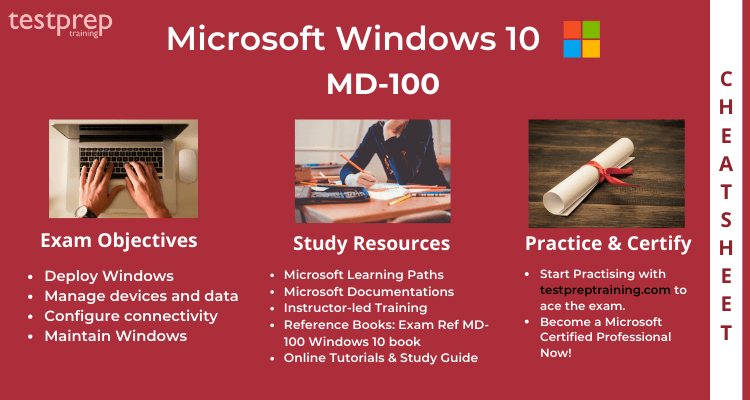Are you ready to take the next step in your career by becoming a Microsoft Certified Professional? Looking for a quick recap with right study resource? Then you are definitely at the right place. We provide you with Microsoft Windows 10 MD-100 Cheat Sheet will be your information goldmine for your revisions. It includes all the essential study resources to boost up your knowledge and confidence.
Microsoft MD-100: Overview
The Microsoft Windows 10 MD-100 exam equips you with skills to manage identity, access, policies, updates, and apps. As an Administrator, you will typically collaborate with the Microsoft 365 Enterprise Administrator to design and implement a device strategy that meets the business needs of a modern organization.
MD-100 Exam Prerequisites
There are no prerequisites for the Microsoft MD-100 Windows 10 Exam. However you must be familiar with Microsoft 365 workloads. Additionally, you must be proficient and experienced in deploying, configuring, and maintaining Windows 10 and non-Windows devices and technologies
Target Audience : MD-100
The MD-100 Certification Exam is valuable for new IT Professionals with at least a year of working in Windows 10, and also for experienced desktop support specialists looking to validate their Windows 10 skills. This MD-100 exam covers everything you need to know to run an enterprise Windows 10 environment.
Certification Details
With the successful completion of MD-100 : Windows 10 and MD-101 : Managing Modern Desktops you will earn the certification Microsoft 365 Certified: Modern Desktop Administrator Associate.

Cheat Sheet
Cracking the certifications like Microsoft Windows 10 Exam can be challenging enough. But the exam is worth taking as this gives you global recognition in this field along with the access to huge community. This cheat sheet will provide a quick summary of all the essential resources to crack the exam. Moreover, it will set you on the right track to ace this exam

Revise the exam objectives
Firstly, you need to go through the Official guide of Microsoft MD-100 exam. Familiarise yourself with all the objectives and course domains of the exam. Also, devote enough time to each topic and have in depth knowledge of the subject by tailoring your study focus around the course domains. Moreover, the official guide acts as a blueprint for the exam, hence always remember to refer it.
Microsoft MD-100 exam updated course outline as on March 8, 2021
This exam covers the following domains:
1. Deploy Windows
Install Windows 10
- perform a clean installation (Microsoft Documentation: Start afresh with a clean installation of Windows 10)
- perform an in-place upgrade (using tools such as WDS, ADK, etc.) (Microsoft Documentation: Perform an in-place upgrade to Windows 10 with MDT, Windows 10 deployment scenarios and tools)
- select the appropriate Windows edition (Microsoft Documentation: Windows 10 edition upgrade, Upgrade Windows devices to a new edition with Configuration Manager)
Perform post-installation configuration
- configure Edge and Internet Explorer (Microsoft Documentation: Configure IE mode policies, Internet Explorer (IE) mode)
- configure mobility settings (Microsoft Documentation: Configure Windows 10)
- customize the Windows desktop (Microsoft Documentation: Customizations for desktop devices, Customize)
- troubleshoot activation issues (Microsoft Documentation: Get help with Windows activation errors, Resolve Windows activation error codes)
- configure printers and external devices (Microsoft Documentation: Windows 10 (and newer) device settings to allow or restrict features using Intune, Configuring the device)
- configure Windows 10 by using provisioning packages (Microsoft Documentation: Provisioning packages for Windows 10, Create a provisioning package for Windows 10, Apply a provisioning package)
- configuring Microsoft Store settings (Microsoft Documentation: Configure access to Microsoft Store)
- configure application settings (Microsoft Documentation: Set or edit application protection settings for Windows 10 devices, Configure device settings)
- configure and manage services (Microsoft Documentation: Introduction to Windows Service Applications)
2. Manage devices and data
Manage users, groups, and devices
- managing local groups
- manage local users (Microsoft Documentation: Overview of Local Accounts)
- managing users, groups, and devices in Active Directory Domain Services (Microsoft Documentation: What is Azure Active Directory Domain Services? Administer Group Policy in an Azure Active Directory Domain Services)
- manage users, groups, and devices in Azure Active Directory (Microsoft Documentation: Manage device identities using the Azure portal, Create a basic group and add members using Azure Active Directory, Azure AD built-in roles)
- configure sign-in options (Microsoft Documentation: Use Windows Hello for Business on Windows 10 devices with Microsoft Intune, Windows 10 sign-in options and account protection)
Configure devices by using local policies
- implement local policy (Microsoft Documentation: Local Group Policy Editor, Security policy settings, Configure security policy settings)
- troubleshoot group policies on devices (Microsoft Documentation: Enroll a Windows 10 device automatically using Group Policy, Group Policy troubleshooting documentation for Windows Server)
- configure Windows 10 settings by using group policy (Microsoft Documentation: Use the Settings app Group Policy in Windows 10, Manage the Settings app with Group Policy)
Manage Windows security
- configure user account control (UAC) (Microsoft Documentation: How User Account Control works, User Account Control)
- configure Windows Defender Firewall (Microsoft Documentation: Turn on your Windows Defender Firewall, Best practices for configuring Windows Defender Firewall)
- implement encryption (Microsoft Documentation: Manage BitLocker policy for Windows 10 in Intune, BitLocker Device Encryption in Windows 10)
- configuring Windows Defender Antivirus (Microsoft Documentation: Microsoft Defender Antivirus in the Windows Security app, Configure Microsoft Defender Antivirus features)
3. Configure storage and connectivity
Configure networking
- configuring client IP settings (Microsoft Documentation: ipconfig, change the IP address of a network adapter)
- configure mobile networking (Microsoft Documentation: configure Windows 10 Mobile devices, Configure cellular settings for tablets and PCs)
- troubleshoot networking (Microsoft Documentation: Advanced troubleshooting for Windows networking)
Configure data access and protection
- configure NTFS permissions (Microsoft Documentation: Share and NTFS Permissions)
- configuring shared permissions (Microsoft Documentation: Share and NTFS Permissions)
- configure local storage (Microsoft Documentation: Introduction to Web Storage)
- manage and optimize storage
- configure file and folder permissions (Microsoft Documentation: Access Control Overview)
- configure OneDrive/OneDrive for Business (Microsoft Documentation: OneDrive, OneDrive guide for enterprises, OneDrive QuickStart guide for small businesses)
4. Maintain Windows
Configure system and data recovery
- perform file recovery (Microsoft Documentation: Recover lost files on Windows 10, Recovery in Windows 10 S)
- recover Windows 10 (Microsoft Documentation: Prepare recovery tools for your Windows images, Windows Recovery Environment (Windows RE), Recovery in Windows 10 S)
- troubleshoot startup/boot process (Microsoft Documentation: Advanced troubleshooting for Windows boot problems, Advanced troubleshooting for Windows start-up issues)
- create and manage system restore points (Microsoft Documentation: Restore points, Create a system restore point)
Manage updates
- troubleshoot updates (Microsoft Documentation: Windows Update troubleshooting)
- select the appropriate servicing channel (Microsoft Documentation: Overview of Windows as a service, Assign devices to service channels for Windows 10 updates)
- configure Windows update options (Microsoft Documentation: Manage additional Windows Update settings, Configure Windows Update for Business)
- plan for Windows updates (Microsoft Documentation: Plan for software updates in Configuration Manager)
- configure updates by using Windows Update for Business (Microsoft Documentation: Integrate with Windows Update for Business, What is Windows Update for Business?)
Monitor and manage Windows
- configure and analyze event logs (Microsoft Documentation: Monitor Event Log, Collect Windows event log data sources with Log Analytics agent)
- manage performance
- manage Windows 10 environment Manage (Microsoft Documentation: Windows 10 in your organization, What is co-management?)
- configure local registry (Microsoft Documentation: Windows registry information for advanced users, Registry Class, Configuring the Registry)
- schedule tasks (Microsoft Documentation: Task Scheduler, Task Scheduler for developers, schtasks commands)
Configure remote connectivity
- manage Windows 10 remotely by using Windows Admin Center (Microsoft Documentation: Windows Admin Center, Troubleshooting Windows Admin Center)
- configure remote assistance tools including Remote Assist and Quick Assist (Microsoft Documentation: Use Quick Assist to help users, Remotely assist mobile devices managed by Microsoft Endpoint Manager)
- manage Windows remotely by using Windows Remote Management and PS remoting (Microsoft Documentation: Enable-PSRemoting, Configure Remote Management in Server Manager, Running Remote Commands, About Remote Requirements)
- configure remote desktop access (Microsoft Documentation: Remote Desktop – Allow access to your PC, Get started with the Windows Desktop client, Set up the Remote Desktop web client for your users, Remote Desktop clients)
Quick Links to Resources
Choosing the right resources with reliable content is very important. As a matter of fact, there are various resources to choose from. This makes it difficult to select the authentic and genuine ones. As you have probably been preparing for this exam we hope that you have made a wise choice in terms of your learning resources. However, here area few quick links that will definitely benefit your preparations and help you ace the exam:
Books
Books are the most important ingredient of preparation. There are a vast variety of books available in the market which you can use to prepare for the Microsoft MD-100 Exam. We suggest you the Exam Ref MD-100 Windows 10 book offered at the Microsoft Press Store. This book focuses on the critical thinking and decision-making acumen needed for success at the Microsoft Certified Associate level.
Training Course
Microsoft offers their training courses to provide you with the necessary tools and resources. Microsoft offers the Course MD-100T00-A: Windows 10 as a part of its instructor led training. Also, you get access to online learning course to assist your self- paced learning. Modernize your enterprise deployment with Windows 10 and Microsoft 365 Apps
Online Tutorials and Study Guides
The roadmap to your success is only complete when you have the right strategy. Study Guides will be your support throughout your revision journey. Also, Online Tutorials will result in strengthening your preparation by providing in depth understanding about the exam concepts.
Practice Tests
Finally, it is time to check your preparations. Self-Evaluation is the key and hence your next step is to go for practice tests. The more you’re going to practice, the better for you. Moreover, these practice tests provide you with the real exam environment and also help you analyse areas that need improvement. Strengthening your weaker domains will surely help you pass with flying colours. Therefore, attempt as many practice tests as you can. Start practising now!



